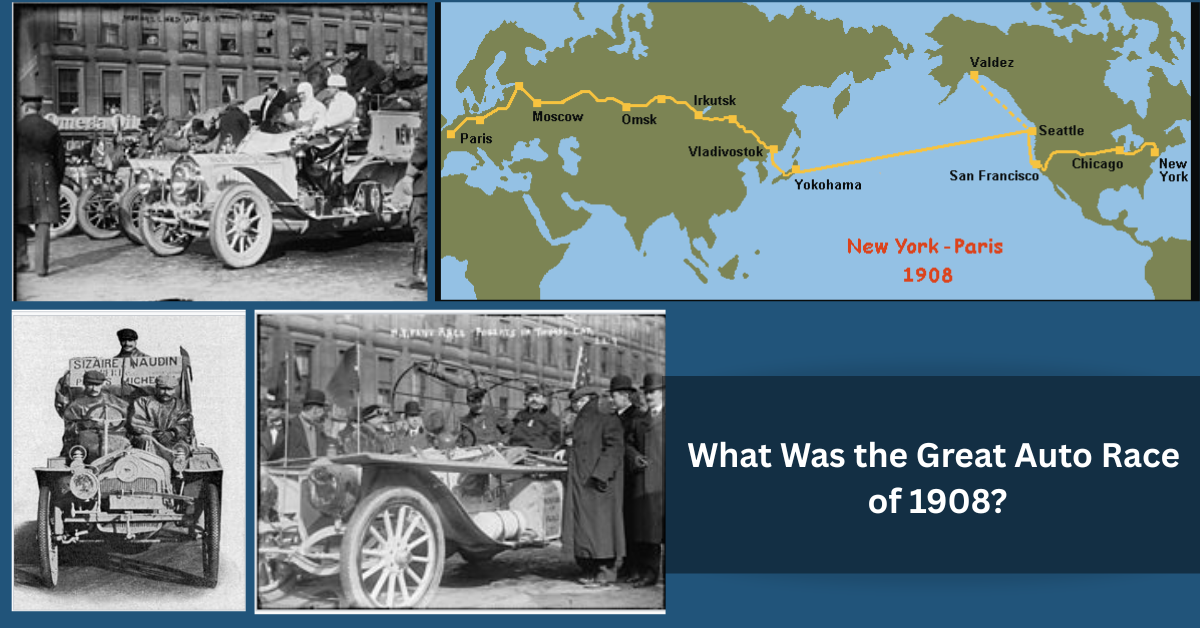History Corner - What Was the Great Auto Race of 1908?

The Great Auto Race of 1908 Begins!
What Was the Great Auto Race of 1908?
Imagine setting off on a journey of more than 22,000 miles—through snowstorms, mud, mountains, and even across the icy plains of Siberia. That’s exactly what six brave teams did on February 12, 1908, when they lined up in New York City for the start of the most ambitious automobile race the world had ever seen: The Great Race from New York to Paris.
Organized by the New York Times and Le Matin of Paris, the race was designed not just to test drivers, but to prove something revolutionary—that the automobile could conquer the world.
Who Entered the Race?
The race featured six teams from four different countries, each showcasing their engineering and endurance.
-
🇺🇸 United States – Thomas Flyer
-
🇩🇪 Germany – Protos
-
🇫🇷 France – Three entries: De Dion-Bouton, Sizaire-Naudin, and Moto-Bloc
-
🇮🇹 Italy – Züst
Each team came equipped with:
-
A driver and mechanic
-
Spare parts (sometimes limited)
-
Maps that were often outdated—or nonexistent
-
The courage to venture into the complete unknown
What Made the Route So Challenging?
This wasn’t a smooth coast-to-coast cruise. The route was beyond grueling. Here’s what the teams faced:
-
Start: New York City
-
Across America: Snowbound roads, no gas stations, and deep mud
-
To Alaska (original plan): But the Bering Strait crossing proved impossible
-
Re-route: Teams shipped cars to Japan and then to Vladivostok, Russia
-
Siberia: Vast, icy wilderness with barely any roads
-
Europe: Final leg through Russia, Germany, and France to reach Paris
Key challenges included:
-
❄️ Extreme weather conditions in the U.S. Midwest and Siberia
-
🔨 Constant mechanical failures
-
🗌 Lack of infrastructure—no proper roads or bridges
-
🐴 Relying on horses or locals to help tow cars out of mud and snow
How Did the Thomas Flyer Claim Victory?
The American entry, the Thomas Flyer, was piloted by George Schuster, a mechanic and self-taught navigator. Their success came down to a few critical factors:
-
🔧 Mechanical reliability: The Thomas Flyer proved incredibly tough and easier to repair on the fly
-
🤭 Navigation skills: Schuster was meticulous with his planning and adapted quickly to changing conditions
-
🤝 Resilience and teamwork: Despite grueling hardships, the U.S. team never gave up
-
⏲️ Consistency: While other teams faced major breakdowns or delays, the Flyer kept moving
The Flyer arrived in Paris on July 30, 1908, finishing first in terms of time and effort, although the German team (Protos) had arrived earlier due to a shortcut but was penalized. In the end, the Thomas Flyer was declared the official winner.
Why Was This Race So Important?
At the time, many people still saw the car as a novelty. The Great Race changed that.
It proved that:
-
🚗 Automobiles could endure extreme environments
-
🌍 Global travel by car was theoretically possible
-
🔧 Engineering, adaptability, and spirit were just as important as speed
-
🌟 It inspired innovation in automobile design, navigation, and endurance driving
What Can We Learn From the Great Race Today?
Though over a century has passed, the lessons of the Great Race still resonate:
-
Adventure begins with courage.
-
Innovation grows from adversity.
-
Teamwork turns the impossible into victory.
-
Every journey—no matter how difficult—starts with a single turn of the key.
What’s the Most Epic Road Trip You’ve Been On?
The Great Auto Race of 1908 is a reminder that every road trip holds the potential for greatness. Whether it's a drive across a continent or a scenic weekend escape, your journey can become a story worth telling.
👉 Tell us your most unforgettable road trip memories!
Where did you go? What challenges did you face? What moments made it unforgettable?
We’d love to hear your stories in the comments below! 🚙💬
🏎️ Final Thought
From New York to Paris, across continents and chaos, the Great Auto Race of 1908 remains one of history’s most thrilling adventures on wheels. The Thomas Flyer didn’t just win a race—it helped ignite the global love affair with the automobile.


